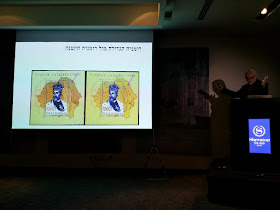 |
| 33rd Conference of Israeli Philatelists | כנס יום הבולאות |
The 33rd Conference of Israeli Philatelists was held on 25 December 2019 at the Sheraton Hotel in Tel Aviv. Organized by the Israel Philatelic Federation, the event featured seven speakers and numerous award ceremonies and included a raffle and an auction. Each event attendee was given a limited-edition souvenir leaf with a uniquely CTOed 2019 Weizmann Institute stamp prepared exclusively for the event. A light breakfast buffet was laid out as guests made their way to the conference area, mingled and rushed to save seats in the conference hall.
 |
| Eli Weber | אלי ובר |
 |
| Ronen Goldberg (left) | רונן גולדברג |
 |
| Miri Nistor (left) | מירי ניסטור |
 |
| Yivsam Azgad | יבשם עזגד |
 |
| Elhanan Shapira | אלחנן שפירא |
 |
| Moshe Rimer (left) | משה רימר |
 |
| Matan Ber (second from left) | מתן בר |
 |
| Genady Berman (center) | גנדי ברמן |
 |
| Zvi Aloni | צבי אלוני |
 |
| Arie Olewski | אריה אולבסקי |
 |
| Hedy Feivel | הדי פייבל |
 |
| Moshe Rimer | משה רימר |
 |
| Amir Afsai | אמיר אפסאי |

No comments:
Post a Comment